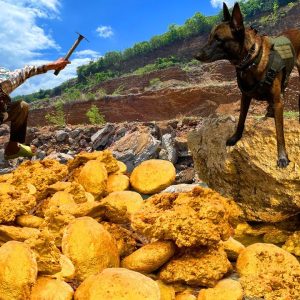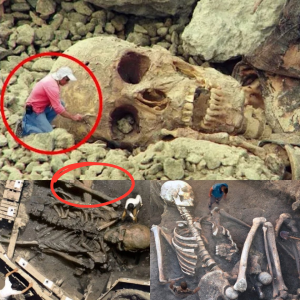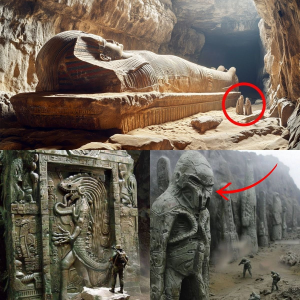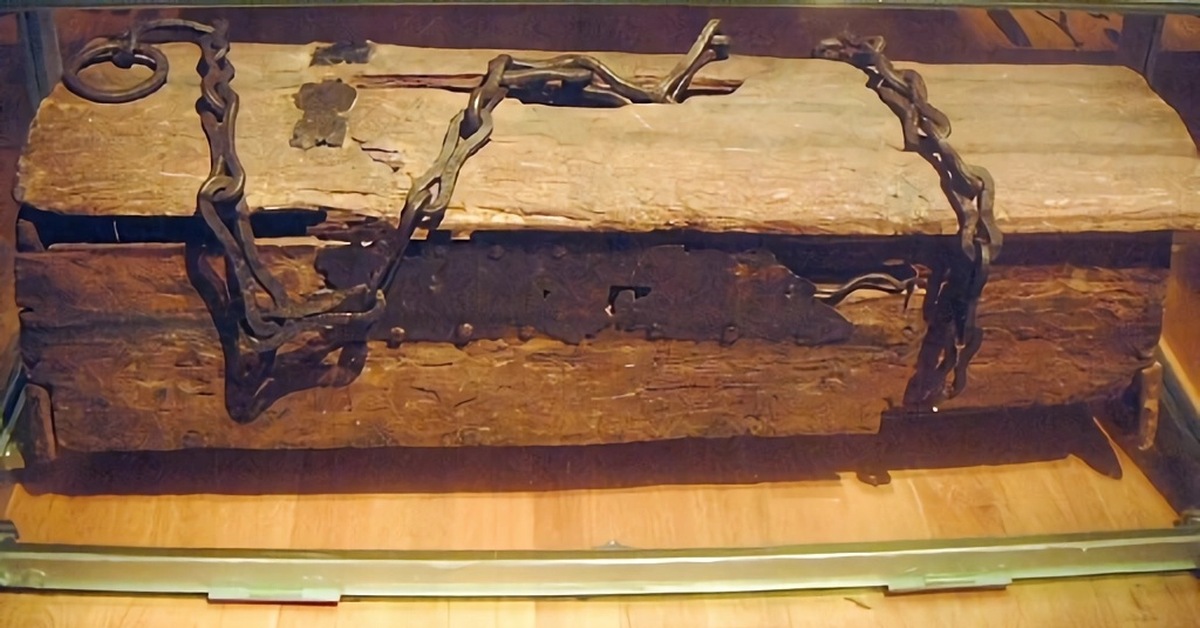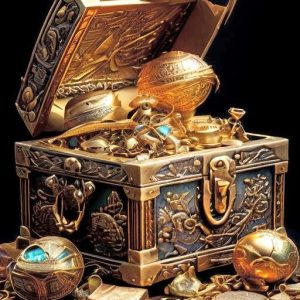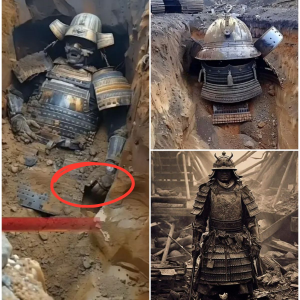William S. Crosby of Manitou Springs and Harold Ashenhurst of Texas may have come up with the idea, but it took the influence and political experience of Virginia McClurg — one of the original preservationists behind Mesa Verde National Park, which was less than a year old — to make it happen. Her involvement was scandalous; her life’s work had been to stop the looting of archaeological sites, but here she was, endorsing a plan to relocate an entire pueblo in the name of preservation.
Workers were paid a respectable $2.50 a day to unearth the millennium-old village, using shovels, rakes and hoes. The pueblo — a community hub for hundreds — occupied over an acre of land. Its central structure was almost 20 feet high, surrounded by smaller structures. And, by the spring of 1907, it had been reduced to a million pounds of rock.
Once the railcars arrived, the stones were hauled by horse-drawn carts up to a dramatic red-rock canyon overlooking Manitou Springs. An overhang had been dynamited into the canyon wall, and workers used cement mortar to nestle the stones inside it. Soon, the sandstone masonry was arranged to imitate a cliff dwelling, piles of sandstone clustered alongside it to give it an air of antiquity.
That summer, the Manitou Cliff Dwellings Museum and Preserve opened to the public.

THEY WAITED IN A LONG LINE of cars and paid $12 each for tickets at the entrance booth. In the parking lot, loudspeakers pumped the lilting sounds of generic pan-Indian music, punctuated by the screech of a hawk. “Y’all hear that sacred flute?” Raven Payment asked in a video she posted to Twitter last July, her friend Monycka Snowbird laughing in the background. “What the fuck is this place?”
Payment, who is Kanien’kehá:ka and Anishinaabe, and her friend Monycka Snowbird, who is Anishinaabe, lead the Pikes Peak Indigenous Women’s Alliance, a group of activists and advocates focused on issues impacting Indigenous people. At the attraction, they followed the self-guided tour. With every step, they got angrier. “Every effort to stereotype Natives as primitive, dirty, and diseased was taken,” Payment tweeted. Adding insult to injury, she added, were continual references to offensive terms for the Ancestral Puebloans.
Every year, more than 100,000 tourists and local schoolkids walk, climb and crawl through the pseudo-cliff-style structure and into an even more incongruous tipi, then tour a small museum and a massive three-story gift shop in a building called the Pueblo, where Native workers reportedly lived on site until the 1980s. Visitors can grab a bite at the Kokopelli Café, and, for years, they could have received a kiss from one of the wolves rescued by Colorado Wolf Adventures, which regularly visited.
In the attraction, they found a petroglyph panel, infant funerary artifacts and displays of human skulls and spines, which the attraction says are replicas. The gift shop sold “shaman wisdom cards,” dreamcatcher necklaces, cowboys-and-Indians weapon sets and a children’s booklet that sexualized Ancestral Puebloan women. “It’s exploitative, it’s stereotypical, it’s racist, it’s appropriation,” Payment told me. “Pick an ‘ism,’ you can find it there.”
Over the course of the attraction’s history, it has claimed that the structure is an authentic cliff dwelling from McElmo Canyon, part of the remnants of a long-lost culture. This is untrue. Archival materials prove that the structure is a replica of dwellings found in Mesa Verde National Park, built with the masonry sandstone of a free-standing pueblo. While the attraction’s website and self-guided tour disclose that the structure was relocated, they continue to misrepresent its authenticity and origin. (The attraction removed select instances of the term “authentic” from its website while this article was being reported.)
“It’s exploitative, it’s stereotypical, it’s racist, it’s appropriation. Pick an ‘ism,’ you can find it there.”

Similarly, the website contradicts itself on the one hand by perpetuating the myth of “a great American society now long gone” while also informing visitors that the present-day Taos Pueblo Indians of New Mexico are “descendants of the Cliff Dwelling Indians belonging to the Ancestral Puebloans cultural line.” In a 1907 informational pamphlet, the attraction falsely claimed that the builders of the cliff dwellings went extinct after a volcanic explosion and insisted that “Pueblo Indians are not descended from cliff dwellers.” When asked for comment, Rob Hefner, the attraction’s operations manager, responded that the Ancestral Puebloans “most likely” migrated into the Rio Grande Valley over the course of a hundred years.
According to the Crow Canyon Archaeological Center, Ancestral Puebloans migrated from the Mesa Verde region southward to what is now Arizona and New Mexico beginning around the late 1200s A.D. Many settled in the Rio Grande Valley, and their descendants now live in 32 Pueblo communities in New Mexico, Arizona and Texas. In an email to Manitou’s general manager, Payment and Snowbird demanded that the attraction close until it consulted with Pueblo leaders. Snowbird included Colorado state archaeologists, the Manitou Springs Chamber of Commerce and tribal governments in the email. “This sort of dehumanizing and objectifying behavior is at the basis of all other issues that our people currently face.” They never received a response from the attraction.
Rob Hefner said Snowbird’s email was “negative and attacking,” adding that he would have met with her had she reached out individually with her concerns. He said they had removed offensive terms, though Ifound them on visitor handouts, children’s educational materials, at least one information plaque, on gift shop items and the attraction’s social media. Hefner declined to comment on Payment’s accusations of racism and appropriation. “Our preserve and museum has continued to be praised by many professors, teachers, educators, and Indigenous Tribes over the years for our preservation, educational efforts, and school tours,” Hefner said in an email.
IN 1896, THEOPHIL Mitchell Prudden wrote, “A summer among cliff dwellings” for Harper’s Magazine, observing a couple hiking to some southwestern cliff dwellings, carrying baskets and excavation tools. There, the man showed his affection by looting artifacts for his sweetheart. As he dug, she reclined under a parasol, “cosily seated amid piles of broken pottery, darting lizards, and dead men’s bones.”
Perhaps the picnickers were looking for pottery, or maybe centuries-old macaw feathers, turquoise or jewelry, relics of the vast network of Ancestral Puebloan trading routes. Looting was common in the Four Corners in the late 1800s and early 1900s as private collectors and institutions accumulated Indigenous artifacts at an alarming rate.
Appalled by this cultural destruction, Iowa Rep. John Lacey and archaeologist Edgar Lee Hewett drafted the Antiquities Act, which Theodore Roosevelt signed into law on June 8, 1906. The act provided legal protection for cultural, natural and scientific resources across the U.S. and gave the president the authority to create national monuments on federal land to protect these resources. But it also forced some Native people from their ancestral lands and reservations, in the name of preserving them for a wider public. At the time, Native Americans were still denied full citizenship and could not vote in national elections.
Women could not yet vote nationally either, but a few states, including Colorado, had passed women’s suffrage. Women involved in historic preservation seized their opportunity. Virginia McClurg and Lucy Peabody founded the Colorado Cliff Dwellers Association in 1900, under the motto Dux Femina Facti, Latin for “A woman was the author of the achievement.” Its mission was to preserve the thousands of Ancestral Puebloan sites in the Mesa Verde region of southwest Colorado, where famous dwellings like Cliff Palace, Spruce Tree House and Balcony House still survive, tucked beneath enormous overhangs in the mesa’s juniper-dotted canyons, a landscape that was home to several thousand Pueblo people from around 1100 to 1285 A.D.
Determined to protect these sites from further looting and destruction, McClurg enlisted the support of over 250,000 women. As the association’s leader, she corresponded with politicians, raised money and spoke with Ute leaders Chief Ignacio and Chief Acowitz, acquiring the lease that laid the foundation for a future park — but also significantly shrank the Ute Mountain Ute Reservation.



Peabody, a secretarial assistant at the Smithsonian Institution’s Bureau of American Ethnology, was McClurg’s vice regent and one of the group’s most passionate members. In 1901, the association invited prominent journalists and archaeologists, including the famed naturalist Jesse Walter Fewkes, on a tour of Mesa Verde, hoping to gain their support for a park’s creation.
As time passed and various park bills died in Congress, McClurg and Peabody’s joint vision diverged. McClurg wanted Mesa Verde to be a state park, where she might have influence over its management. Peabody, who believed the park would be better protected under federal control, resigned from the association. She went to Washington, D.C., with Hewett, co-author of the Antiquities Act, to advocate for a national park. On June 29, 1906, Mesa Verde National Park — sometimes known as “The Women’s Park” because of the association’s involvement — was established. In the process, over 42,000 acres were taken from nearby reservations.
McClurg was bitterly disappointed that control went to the federal government. To the dismay of her colleagues and supporters, she seemed to pivot entirely. Within months, she became a stockholder in the Manitou Cliff Dwellings Museum and Preserve scheme. Many of McClurg’s supporters resigned from the association when the plans were made public.
Hewett was disgusted by the idea. “The removal of any such structure from its original situation (is) a serious loss to science; so serious that it has been made an offense against the laws of the United States,” he wrote in a letter to Atherton Noyes of the Colorado Archaeological Society. “The probability of error in reconstruction (of Manitou) is so great as to make the result valueless if not actually misleading and pernicious.”
But Hewett and Noyes knew nothing about the greatest gimmick behind the Manitou Cliff Dwellings Museum. Documents from local Cortez historian Fred Blackburn’s extensive historic library, newspaper and research archive of the Four Corners reveal that Crosby and Ashenhurst had no desire to relocate an actual cliff dwelling and reassemble it stone by stone. Instead, they planned to pillage a pueblo, despite it being a different style of architecture, and use its masonry to replicate one of Mesa Verde’s most well-known structures — creating an archaeological Frankenstein’s monster.
“The removal of any such structure from its original situation (is) a serious loss to science; so serious that it has been made an offense against the laws of the United States.”
According to a 1906 article in the Montezuma Journal, Crosby planned to create a “blueprint” inspired by Mesa Verde’s architecture and use it to construct a “facsimile” at the attraction. In February 1907, Noyes saw those drawings. “(They showed) parts of the Balcony House, the Cliff Palace, and the Spruce Tree House are to be made in replica,” he wrote to Hewett. “The measurements, in height and depth, are the same as in the originals.” One of the attraction’s brochures from 1907 proudly highlighted the features copied from Mesa Verde, while another, in 1946, boasted that the dwellings at Mesa Verde couldn’t hold a candle to theirs. Today, that language is gone, replaced with claims of authenticity and an endorsement from Hewett, who reversed course and attended the attraction’s opening day.
“I DIDN’T KNOW ABOUT Manitou until I worked at Mesa Verde,” TJ Atsye told me, sitting at a picnic table outside the national park’s visitor center. Dark-eyed juncos darted across the chamisa; the San Juan Mountains were dusted with early snow. “Our visitors would mention that they were up seeing the pueblo in Manitou Springs, and I thought, ‘What pueblo?’As a Pueblo person from Laguna, a descendant here from the people of Mesa Verde, the Pueblo people didn’t live or migrate into that part of the state of Colorado.”
Atsye, 67, wears her white hair in short bangs. She can trace her ancestry on both sides back to the great-grandparents of her great-great-grandparents. A former seasonal park ranger, she worked at Mesa Verde from 2015 to 2019, and her words and perspective are still displayed throughout the park. Her voice plays on a loop on the self-guided tour, where she interprets the park from the perspective of a Laguna Pueblo woman. Her quotes appear on plaques, explaining the importance of the archaeological sites and giving a glimpse into what daily life may have been like for her ancestors.
It wasn’t always this way. For decades, Mesa Verde National Park misled visitors, repeating the myth of a “vanishing” civilization. Historian Joseph Weixelman documented in his book, Hidden Heritage, that the park’s interpretation “vacillated” between the romantic mystery of disappearance and the truth that modern-day Puebloans were descendants of Ancestral Puebloans. Campfire talks, plays and other performances at Mesa Verde in the 1920s also warped the public’s perception of Ancestral Puebloans, as many of the plays supposedly about the “cliff dwellers” featured Navajo performers and customs.
“We as Pueblo people are still here. We just relocated and we migrated, and we found a new place to live.”
The park also suggested even darker interpretations. One early exhibit Weixelman described — removed in the 1920s — displayed human remains in Pipe Shrine House. There visitors could open a door “to see how Ancestral Puebloans buried their dead.” According to Mesa Verde park ranger Spencer Burke, misinformation continued to be disseminated at the park until the early 2000s. But as the park began to work with more Pueblo tribes as a result of the Native American Graves Protection and Repatriation Act (NAGPRA) of 1990, its interpretation slowly evolved. Today, it tries to prioritize Indigenous knowledge; for example, Zia and Zuni Pueblo elders teach rangers about the Pueblo people who regard the sites as their ancestral homes.
When Atsye told park visitors who had been to the attraction at Manitou that the Ancestral Puebloans never lived there, they looked at her as if she was crazy. “I’m sorry if there is a misconception,” she would tell them. She explained that Ancestral Puebloans did not vanish. A combination of drought, politics and other factors forced her ancestors to leave Mesa Verde. “The land was played out,” she said. “People could not be supported by what was here, game was getting scarce. So what are the leaders supposed to do when they can’t provide this for their community? Do we take the adventure of going someplace else?” They walked south into the Rio Grande Valley, over time splitting into separate pueblos. Atsye’s ancestors established the Laguna Pueblo. “We as Pueblo people are still here,” Atsye said. “We just relocated and we migrated, and we found a new place to live.”
It’s impossible to spend any length of time with Atsye without noticing how generous she is with her judgments. “I’ve always been an idealist,” she said. “I like to think I still am a Pollyanna. An optimist. But I’ve also learned to be real.” According to Atsye, perpetuating contradicting information about Ancestral Puebloans does active harm to Pueblo people. “Not having the correct information damages us and has caused us to work harder to prove that we are still here, that we’re living, thriving, productive people,” Atsye told me. But she believes there is a chance to make it better. “Pueblo people and Native peoples all over have continued to be vocal advocates for these issues,” she said. “People are finally listening to us, and we are getting support from non-Native peoples because they see the indignities and the injustices and want to make it right.”
She wants the attraction’s inaccuracies to be resolved constructively. Pueblo consultation, she believes, is necessary for its transition into the 21st century. “Work together to make it right if (the attraction’s owners) are going to exhibit and claim (authenticity) about this particular site that (was) ripped out of the ground,” Atsye said.
ONE ROOM IN THE MANITOU GIFT SHOP features a collection of historic photographs of the attraction’s past Indigenous performers. One shows Pedro Cajete, or “Chief Manitou,” as the photo caption reads, wearing a beaded vest and large feathered headdress and holding a six-shooter. The label claims the image is from “around 1920” and that Cajete is “Ute Indian.”
Cajete wasn’t Ute. “He was Pueblo through and through,” his great-grandson Gregory Cajete told me over the phone from Rio Rancho, New Mexico, in March. “He was actually somewhat of a celebrity there in Manitou Springs.” Cajete, an entrepreneur, also worked with other businesses in the resort town, including other nearby tourist attractions.
Cajete was one of the first in a long line of Santa Clara Pueblo people to perform at Manitou, dancing and taking photos with thousands of tourists. Rob Hefner wrote that the last time Indigenous performers danced at the attraction was around 2007 or 2008.
“His focus was making some money for the family,” Gregory Cajete said. His great-grandfather was “creating opportunities for Pueblo people, which was, truthfully, almost nonexistent outside of the Pueblo economy itself. There wasn’t very much that people could do except to sell aspects of their culture and tradition. But, you know, I think he did it with good intentions, so I don’t hold that against him.”
“There wasn’t very much that people could do except to sell aspects of their culture and tradition.”

Gregory Cajete is the former director of Native American Studies at the University of New Mexico, and he has studied attractions similar to Manitou. He says that many others exist across the country, misrepresenting Indigenous cultures as a foundation of their business model. “It’s one snapshot in a much larger complex that was going on at that time,” he told me. “The deeper issue is, how do you represent another people’s way of life, their traditions, their history, in an honest and respectful way? I think a lot of the museums are beginning to attempt to do that.”
When I visited the attraction this winter — the first time since I went with my elementary school class in the early 2000s — it still had a ways to go. Christmas lights were coiled around the Kokopelli-themed street lamps when I met Katie, the employee assigned to give me a rare in-person tour, at the faux cliff dwellings. We wove in and out of them, ducking our heads under wooden beams as she spoke about the Ancestral Puebloans. They lived to be “25-30,” she said, had “flat skulls,” because of cradleboards, and “bad teeth.” Before the pandemic, Katie told me she used to lead the school tours.
After Katie left, I sat at the north end of the Disneyfied structures as white tourists squeezed their bodies through the windows of a building modeled after Balcony House. I spoke with many of the visitors, including two small groups from out of state. Only one set of visitors questioned the attraction’s authenticity; most thought Ancestral Puebloans had lived in the canyon.
In the fall of 2021, Manitou’s longtime owner, Donna Rogers, passed away. The attraction’s future is unclear, but Hefner expects it to stay in the family, which has owned it for three generations. Hefner could not provide any documentation about the origins of the masonry or most of the attraction’s other items, which the website claimed at time of publication were from McElmo Canyon, a natural feature that is home to many Ancestral Puebloan archeological sites. “It is my personal belief that there may be some collection of truth to a lot of these theories,” Hefner said over email. “It’s unfortunate that with the change of ownership around WWII, the archives and history were lost other than to different theories and ideas in books, articles and stories over the years.”
Hefner claimed that Rogers donated “thousands of dollars each year but to whom and how much or how often I do not know.” Manitou Cliff Dwellings did not provide any proof of donations to Pueblo tribes or other organizations, although its Instagram account reveals that it was a platinum sponsor of the 2015 Manitou Springs Colorado Wine Festival.
Asked multiple times about the repatriation of human remains and funerary items, Hefner could not provide documentation. “I do not know,” he wrote, “but I would once again assume that when artifacts were repatriated, there would have been some sort of a list to designate what items were to be repatriated and what items were acceptable to keep on display.”

According to NAGPRA, any institution that receives federal funds and has possession of, or control over, Native American cultural items — including human remains, funerary objects, sacred objects, or items of cultural patrimony — is classified as a museum. High Country News located records that show that Dontom Inc., the S corporation that owns Manitou Cliff Dwellings, received a Paycheck Protection Program loan on May 1, 2020, for $153,032. An official from the National NAGPRA Program told me that whether a PPP loan qualifies as the receipt of federal funds for purposes of NAGPRA is determined on a case-by-case basis.
“If they’ve received federal funding, they’re just like any other museum under NAGPRA,” said Shannon Keller O’Loughlin, attorney and the executive director at the Association on American Indian Affairs. “Within six months of receiving federal funding, you’re to provide a summary of the holdings or collection as required by section 10.8 (of the regulation.)”
“They are already out of compliance” if the attraction’s loans are deemed federal assistance, O’Loughlin (Choctaw) told me by phone, explaining that tribes could take them to a NAGPRA review committee for alternative dispute resolution of the issue. Manitou could face civil penalties if a complaint was filed to the National NAGPRA Program. “They are grave robbers and looters,” O’Loughlin said of those who removed the original pueblo, adding that the entire structure could be considered cultural patrimony. “That means all of that would need to be repatriated,” she told me.
Hefner wrote that he did not believe the structure should be open to claims of repatriation and claimed that the entity that owns the “physical Dwellings” never received any federal funding or PPP loans. He also wrote that he did not know whether the attraction had ever composed a summary of its items, but said that, if so, he assumed it happened in the ’80s. In response to claims of the parties responsible for moving the structure being named “grave robbers and looters,” Hefner wrote over email, “On the contrary, MCD ultimate goal 120 years ago was to preserve and protect the Ancestral Puebloan culture and architecture from Pot Hunters and Grave Robbers.”
Atsye thinks that the attraction’s managers should“call some Native tribal elders in to discuss what the future of that site can mean to Native people without harming them,” she told me. “Provide the facts that they did this, and why they did it.” The All Pueblo Council of Governors declined to comment when I reached out in March.
“The spirit of what was there is still there. The term ‘ruins’ needs to evolve and change so that people know that it is still living, that it still is still alive.”
THE HAYFIELD SPARKLED like water in the sun. “That’s all artifacts,” Fred Blackburn told me. I squatted in the dry grass; scattered everywhere were thousands of radiant pottery sherds, chert flakes and hammerstones.
This was the original location of the pueblo. I was visiting with Blackburn, a local historian, on an unseasonably warm December morning. The pueblo, which became known in the early 1900s as the Blanchard Ruin, were on flat land, proving to my own eyes that the structures at the Manitou attraction were never cliff dwellings. The expert masonry and close proximity to the Dolores railroad made it an excellent candidate for removal.
“I firmly believe that the 1906 Antiquities Act saved (the cliff dwellings of) Mesa Verde from what occurred at the Blanchard Ruin,” Blackburn told me.
Various documents from Blackburn’s archive, including a 1919 book by the Smithsonian archaeologist Fewkes, led Blackburn to the Blanchard Ruin. The book contained two black-and-white photos of the site and noted that the rock from it was taken by private parties and reassembled into a cliff dwelling in Manitou Springs.
Although the buildings have been relocated and their original location bulldozed and built over throughout the past century, the landscape still provides clues as to where the different structures stood.
We walked around the property with its new owner, a welder in his mid-30s, and found a depression the length of a pickup truck. Blackburn suspects that’s where the great kiva stood. Nearby, a barn and three-bedroom ranch house hid the scars of the main structure’s foundation. The owner said he plans to rent the property as an Airbnb.
To Atsye, all Ancestral Puebloan sites are sacred and alive. “‘Ruin’ just means something is dead,” she told me, “But the spirit is there. … That’s why when you go to a site, you tread lightly. You be respectful of what was there before, because the spirit of what was there is still there. The term ‘ruins’ needs to evolve and change so that people know that it is still living, that it still is still alive.”
Once, while she was at Mesa Verde, Atsye was invited to view the park’s museum collection in the Mesa Verde Visitor and Research Center of over 3 million objects from the Mesa Verde region. “There were drawers open with ladles and hammers and just all kinds of stuff that are whole,” she recalled. “I just started crying.
“I can imagine, you know, what it was like for that woman to have made that pot or ladle for cooking or for decoration as things started to evolve. And the creativity of them making a mark on their own piece of pottery.
“But, you know, they had to leave them, they couldn’t take everything except what was probably necessary and useful. The way that I look at it, what they left for us to study and appreciate and let us gain knowledge from who these people really were — they weren’t just people that you read about in history books. They were living, breathing people, like Pueblo people today.”




